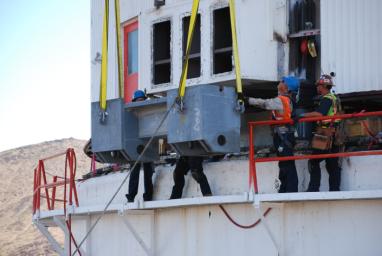
|
Stringer Box Going In
- Click the image above for a larger view
- Full-Res JPEG (3872 x 2592) (713.0 kB)
- Full-Res TIFF (3872 x 2592) (30.1 MB)
Caption:
As part of a major refurbishment for the giant "Mars antenna" at the Deep Space Network's Goldstone Deep Space Communications Complex, a stringer box is lowered into place. The stringer box enables workers to attach support legs so the upper part of the antenna can be lifted. Deep Space Network managers lifted about 3 million kilograms (7 million pounds) of the antenna so they could replace the hydrostatic bearing assembly. The hydrostatic bearing assembly enables the dish to rotate horizontally. The upper part of the antenna was lifted about 5 millimeters (0.2 inches).
This picture was taken on May 4, 2010.
The work on the Mars antenna lasted from March to October 2010. The 70-meter-wide (230-foot-wide) Mars antenna got its nickname from its first task: tracking the Mariner 4 spacecraft after its historic flyby of Mars in 1966. The antenna's official name is Deep Space Station 14.
Background Info:
JPL, a division of the California Institute of Technology in Pasadena, manages the Deep Space Network for NASA Headquarters, Washington. More information about the Deep Space Network is online at http://deepspace.jpl.nasa.gov/dsn/index.html .
Cataloging Keywords:
| Name | Value | Additional Values |
|---|---|---|
| Target | Earth | Mars |
| System | ||
| Target Type | Planet | |
| Mission | Deep Space Network (DSN) | Mariner |
| Instrument Host | Goldstone Deep Space Communications Complex (GDSCC) | |
| Host Type | Ground-Based Observatory | Flyby Spacecraft |
| Instrument | Deep Space Station 14 | Goldstone Solar System Radar |
| Detector | ||
| Extra Keywords | Color, Radar, Radio, Rotation | |
| Acquisition Date | ||
| Release Date | 2010-11-03 | |
| Date in Caption | 2010-05-04 | |
| Image Credit | NASA/JPL-Caltech | |
| Source | photojournal.jpl.nasa.gov/catalog/PIA13558 | |
| Identifier | PIA13558 | |
